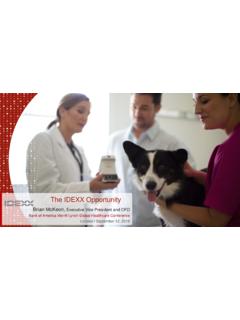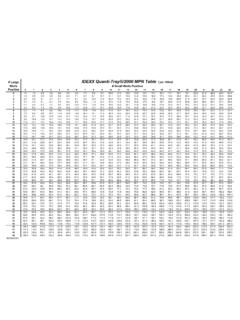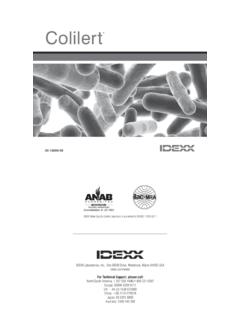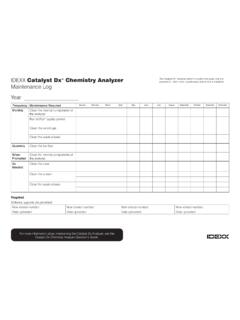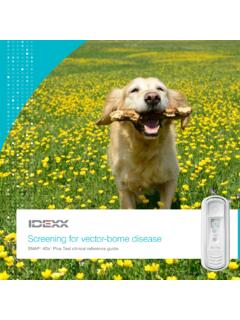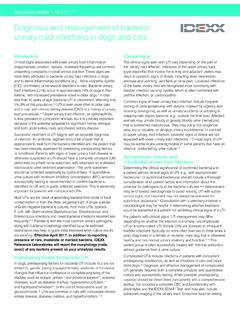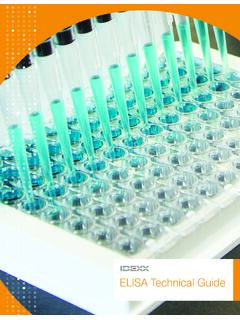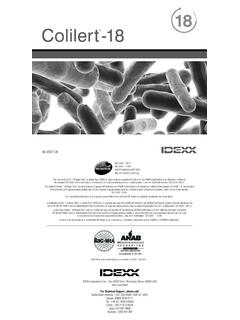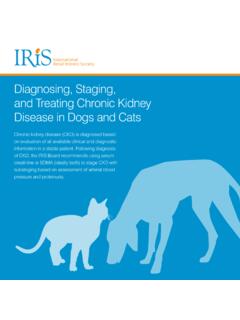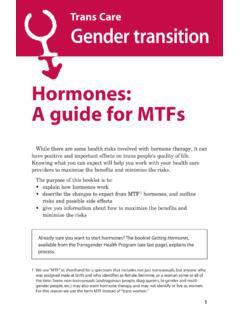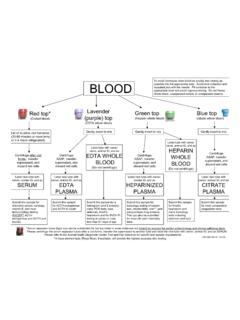Transcription of Catalyst Progesterone Simplifying the Canine Reproductive ...
1 Cata lyst Progesterone 1 Simplifying the Canine Reproductive Cycle Using the Concentration of Progesterone Kurt De Cramer, BVSc, MMedVet (Gyn), PhD Rant en Dal Animal Hospital Introduction Many veterinary practitioners have limited access to bitches that are in estrus and they may lack the experience to interpret Reproductive examinations such as vaginal speculum examinations and vaginal smears. Progesterone concentrations (PC) can aid both experienced and less experienced practitioners with Reproductive consultations. Progesterone assays have been available from commercial laboratories for some years, but the turnaround time impedes their usefulness in cases where immediate clinical decisions need to be made.
2 Point-of-care (in-house) Progesterone assays are now available, allowing for immediate results within the patient visit. Experienced dog breeders are aware of the value of Progesterone testing. It is recognized that in the dog up to 75% of failures to conceive can be attributed to incorrect timing of breeding. The reason it is so difficult to time ovulation in the absence of hormone testing is that the stages of the Canine estrous cycle vary considerably in length. Proestrus is defined as the period from onset of vulvar bleeding to the first acceptance of copulation; its duration averages 9 days, but it can range from 1 27 days in extreme Proestrus is followed by estrus. Estrus refers to the stage where the bitch shows outward signs of receptivity, and it is the stage during which the bitch allows mating.
3 Estrus averages 9 days, but it can range from 3 21 days in extreme These extreme variations have led to the belief that the bitch s heat cycle is very elastic and variable. It is only in late estrus that the bitch ovulates and that, a couple of days later, eggs become fertilizable. Fertilization typically occurs between 3 4 days before the end of estrus. The problem is that in observing a bitch during her heat cycle, there is no way of knowing when the end of estrus will be. To complicate matters, some bitches may bleed throughout their entire heat period, whereas other may not. Furthermore, some bitches may stand for a stud willingly, even long before there are eggs available for fertilization, whilst others may only be receptive for a day or two.
4 Certain bitches may not be willing to stand for a stud at all because they only stand for a particular stud. There are many other variations and idiosyncratic behaviors that can confuse the breeder, all contributing to a missed opportunity to breed the bitch successfully. It is also a common misconception among breeders that the duration of the different stages within a heat cycle and the point at which a bitch will allow copulation replicates itself in each repeating heat cycle of each individual bitch. The breeder then uses the data from a previous cycle and applies it to the next cycle. For instance, because a bitch was previously successfully bred on day 10 (starting from first signs of heat), the breeder will keep on mating that specific bitch on day 10.
5 While this might work in some cases, it most certainly won t work in all cases. Similarly, it is not always true that the stud can sniff out exactly when the bitch is at her peak (optimum time for fertilization). More precise timing of the breeding events is required when there is limited access to the stud, when artificial Reproductive techniques are going to be used, or when the quality of the semen is questionable. The ability to accurately time breeding is of practical and economic importance to breeders. Optimal timing helps breeders in the following ways: Maximizes pregnancy rates and litter size (Semen and stud fees are expensive.) Allows the breeder to plan travel for matings Allows optimization of time for assisted breeding techniques (artificial insemination [AI] using fresh, chilled, or frozen sperm) Allows optimization of time for breeding when access to the stud is limited to one or two matings Prevents unnecessary use of male Helps with the planning of matings when the same male is used on two bitches simultaneously Allows optimization of time for breeding in bitches that have a history of unreceptiveness or show silent heats Ovulation timing for fair estimates of expected whelping dates 2 Hormonal events during the bitch s heat cycle Figure 1.
6 Chronological relationship between PC and key events in estrous cycle. Progesterone starts to rise just before ovulation, toward the last week of the heat cycle. It is well established that as soon as the Progesterone levels are around 2 ng/mL, the ovulation hormone (luteinizing hormone or LH) peaks and that ovulation takes place 2 days later when the Progesterone levels are around 5 8 ng/mL. Canine eggs cannot be fertilized immediately after ovulation because they need another 2 days to mature, and by that time the Progesterone levels usually average 10 ng/mL or above. Other methods used to monitor the estrous cycle to optimize the time of breeding in the bitch As mentioned, the behavioral signs of heat can be very misleading and reveal little else other than the fact that the bitch is indeed in heat.
7 Over the years, many methods have been made available to veterinarians and breeders to assist them in the timing of ovulation and breeding. These methods measured the vaginal pH, salinity, electrical conductivity or resistance, ferning patterns in the vaginal mucous, glucose content, and other parameters. The results of these methods did not correlate well, however, with the actual time of ovulation. Further, Progesterone test kits that performed semiquantitative evaluation of the Progesterone concentration proved much less useful and reliable than quantitative assays that give an accurate Progesterone concentration numerical value. Vaginal smears are only useful to confirm that the bitch is in heat and to see if there is pathology such as a severe vaginitis.
8 Vaginal smears cannot accurately reflect the bitch s heat cycle; they cannot indicate at what point in the heat cycle the bitch is, when a mating should take place, or indeed predict in how many days her heat cycle will be ,4 Vaginal smears are, however, very useful in determining when the bitch is out of heat, and this again is very helpful to accurately determining the date of Vaginal speculum examination in the hands of experienced operators is an acceptable estrous monitoring tool. It guides clinicians as to when they should start collecting blood samples for Progesterone assay, especially in instances when breeding with fresh semen of good quality is planned or when there are no restrictions regarding the use of the stud.
9 Vaginal speculum examinations may save the breeder the cost of Progesterone assays; however, for critical breedings (compromised semen, chilled, or frozen semen) and aberrant heat cycles, this method lacks 3 Number of Progesterone tests required to assess the heat cycle and subsequent decision making Financial constraints and the inconvenience and time constraints to keep on presenting the bitch may limit the number of assays the veterinarian is permitted to perform. In some cases, the breeder might present a bitch too late in her heat cycle to allow for serial blood sampling in order to plot a Progesterone curve. Experienced practitioners that are familiar with vaginoscopic examinations are also better equipped to correlate single Progesterone results with clinical events.
10 One of the most important reasons that a number of Progesterone assays are required is to circumvent the following error: Clinical experience shows that some bitches have a spurious rise of Progesterone (sometimes as high as 2 3 ng/mL) that occurs during estrus followed by several days where the Progesterone remains low (well below 2 ng/mL). This spurious rise may then be followed by a second but true rise above 2 ng/mL and subsequent immediate and steep continued rapid rise in the days thereafter. If the practitioner, for instance, had noticed the Progesterone rising to, say, ng/mL and had only taken a single blood sample, the timing would be incorrect. When the single Progesterone value is around 6 ng/mL during estrus or thereabouts, the timing is likely to be more reliable and good results can be obtained when using fresh semen for breeding.
